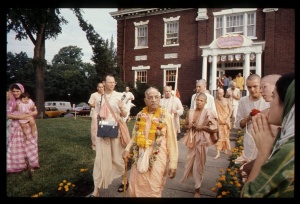CC Madhya 1.227: Difference between revisions
m (1 revision(s)) |
(Vanibot #0054 edit - transform synonyms into clickable links, which search similar occurrences) |
||
| (One intermediate revision by one other user not shown) | |||
| Line 1: | Line 1: | ||
{{ | [[Category:Sri Caitanya-caritamrta - Madhya-lila Chapter 01|C227]] | ||
<div style="float:left">'''[[Sri Caitanya-caritamrta|Śrī Caitanya-caritāmṛta]] - [[CC Madhya|Madhya-līlā]] - [[CC Madhya 1|Chapter 1: The Later Pastimes of Lord Śrī Caitanya Mahāprabhu]]'''</div> | |||
<div style="float:right">[[File:Go-previous.png|link=CC Madhya 1.226|Madhya-līlā 1.226]] '''[[CC Madhya 1.226|Madhya-līlā 1.226]] - [[CC Madhya 1.228|Madhya-līlā 1.228]]''' [[File:Go-next.png|link=CC Madhya 1.228|Madhya-līlā 1.228]]</div> | |||
{{CompareVersions|CC|Madhya 1.227|CC 1975|CC 1996}} | |||
{{RandomImage}} | |||
==== TEXT 227 ==== | ==== TEXT 227 ==== | ||
<div | <div class="verse"> | ||
prāte cali’ āilā prabhu ‘kānāira nāṭaśālā’ | :prāte cali’ āilā prabhu ‘kānāira nāṭaśālā’ | ||
dekhila sakala tāhāṅ kṛṣṇa-caritra-līlā | :dekhila sakala tāhāṅ kṛṣṇa-caritra-līlā | ||
</div> | </div> | ||
| Line 12: | Line 16: | ||
==== SYNONYMS ==== | ==== SYNONYMS ==== | ||
<div | <div class="synonyms"> | ||
''[//vanipedia.org/wiki/Special:VaniSearch?s=prāte&tab=syno_o&ds=1 prāte]'' — in the morning; ''[//vanipedia.org/wiki/Special:VaniSearch?s=cali’&tab=syno_o&ds=1 cali’]'' — departing; ''[//vanipedia.org/wiki/Special:VaniSearch?s=āilā&tab=syno_o&ds=1 āilā]'' — came; ''[//vanipedia.org/wiki/Special:VaniSearch?s=prabhu&tab=syno_o&ds=1 prabhu]'' — the Lord; ''[//vanipedia.org/wiki/Special:VaniSearch?s=kānāira&tab=syno_o&ds=1 kānāira] [//vanipedia.org/wiki/Special:VaniSearch?s=nāṭaśālā&tab=syno_o&ds=1 nāṭaśālā]'' — to the place of the name Kānāi Nāṭaśālā; ''[//vanipedia.org/wiki/Special:VaniSearch?s=dekhila&tab=syno_o&ds=1 dekhila]'' — saw; ''[//vanipedia.org/wiki/Special:VaniSearch?s=sakala&tab=syno_o&ds=1 sakala]'' — all; ''[//vanipedia.org/wiki/Special:VaniSearch?s=tāhāṅ&tab=syno_o&ds=1 tāhāṅ]'' — there; ''[//vanipedia.org/wiki/Special:VaniSearch?s=kṛṣṇa&tab=syno_o&ds=1 kṛṣṇa]-[//vanipedia.org/wiki/Special:VaniSearch?s=caritra&tab=syno_o&ds=1 caritra]-[//vanipedia.org/wiki/Special:VaniSearch?s=līlā&tab=syno_o&ds=1 līlā]'' — the pastimes of Kṛṣṇa. | |||
</div> | </div> | ||
| Line 19: | Line 23: | ||
==== TRANSLATION ==== | ==== TRANSLATION ==== | ||
<div | <div class="translation"> | ||
In the morning, the Lord left and went to a place known as Kānāi Nāṭaśālā. While there, He saw many pastimes of Lord Kṛṣṇa. | In the morning, the Lord left and went to a place known as Kānāi Nāṭaśālā. While there, He saw many pastimes of Lord Kṛṣṇa. | ||
</div> | </div> | ||
| Line 26: | Line 30: | ||
==== PURPORT ==== | ==== PURPORT ==== | ||
<div | <div class="purport"> | ||
In those days in Bengal there were many places known as Kānāi Nāṭaśālā, where pictures of the pastimes of Lord Kṛṣṇa were kept. People used to go there to see them. This is called kṛṣṇa-caritra-līlā. In Bengal there are still many places called hari-sabhā, which indicates a place where local people gather to chant the Hare Kṛṣṇa mahā-mantra and discuss the pastimes of Lord Kṛṣṇa. The word kānāi means “Lord Kṛṣṇa’s,” and nāṭaśālā indicates a place where pastimes are demonstrated. So those places which at the present moment are called hari-sabhā may previously have been known as Kānāi Nāṭaśālā. | In those days in Bengal there were many places known as Kānāi Nāṭaśālā, where pictures of the pastimes of Lord Kṛṣṇa were kept. People used to go there to see them. This is called ''kṛṣṇa-caritra-līlā''. In Bengal there are still many places called ''hari-sabhā'', which indicates a place where local people gather to chant the Hare Kṛṣṇa ''mahā-mantra'' and discuss the pastimes of Lord Kṛṣṇa. The word ''kānāi'' means “Lord Kṛṣṇa’s,” and ''nāṭaśālā'' indicates a place where pastimes are demonstrated. So those places which at the present moment are called ''hari-sabhā'' may previously have been known as Kānāi Nāṭaśālā. | ||
</div> | </div> | ||
__NOTOC__ | |||
<div style="float:right; clear:both;">[[File:Go-previous.png|link=CC Madhya 1.226|Madhya-līlā 1.226]] '''[[CC Madhya 1.226|Madhya-līlā 1.226]] - [[CC Madhya 1.228|Madhya-līlā 1.228]]''' [[File:Go-next.png|link=CC Madhya 1.228|Madhya-līlā 1.228]]</div> | |||
__NOTOC__ | |||
__NOEDITSECTION__ | |||
Latest revision as of 21:11, 19 February 2024

A.C. Bhaktivedanta Swami Prabhupada
TEXT 227
- prāte cali’ āilā prabhu ‘kānāira nāṭaśālā’
- dekhila sakala tāhāṅ kṛṣṇa-caritra-līlā
SYNONYMS
prāte — in the morning; cali’ — departing; āilā — came; prabhu — the Lord; kānāira nāṭaśālā — to the place of the name Kānāi Nāṭaśālā; dekhila — saw; sakala — all; tāhāṅ — there; kṛṣṇa-caritra-līlā — the pastimes of Kṛṣṇa.
TRANSLATION
In the morning, the Lord left and went to a place known as Kānāi Nāṭaśālā. While there, He saw many pastimes of Lord Kṛṣṇa.
PURPORT
In those days in Bengal there were many places known as Kānāi Nāṭaśālā, where pictures of the pastimes of Lord Kṛṣṇa were kept. People used to go there to see them. This is called kṛṣṇa-caritra-līlā. In Bengal there are still many places called hari-sabhā, which indicates a place where local people gather to chant the Hare Kṛṣṇa mahā-mantra and discuss the pastimes of Lord Kṛṣṇa. The word kānāi means “Lord Kṛṣṇa’s,” and nāṭaśālā indicates a place where pastimes are demonstrated. So those places which at the present moment are called hari-sabhā may previously have been known as Kānāi Nāṭaśālā.